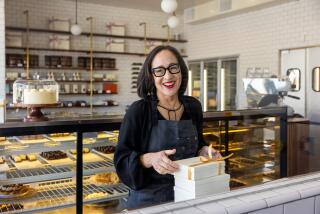Artisanal, hand-crafted chocolate is a growing niche

REDLANDS — Ryan Berk makes his chocolate from scratch. That means flying to Central America four times a year, hiking over Maya ruins to remote jungle villages and meeting face-to-face with the farmers who supply his cocoa beans.
Roasted back home at Berk’s shop, the beans have a habit of enveloping downtown Redlands with a warm smell like brownies fresh from the oven. It’s only then that the chocolate maker with the Indiana Jones streak can mix and shape the ancient treat into bars, carefully wrapping each one by hand.
By trading directly with farmers, artisan producers like Berk believe they can ensure fair prices and preserve a source of unique flavors that largely don’t exist in a business dominated by Wall Street traders and a handful of multinational candy giants.
“It’s a way for us to all profit,” said the 31-year-old former chef who opened his shop, Parliament Chocolate, a year ago. “We need the farmers as much as the farmers need us.”
Berk’s style of chocolate is known in the business as bean-to-bar, and its focus on pure but bold flavors is drawing fans the same way craft beer and artisanal coffee already have. It comes at a time when the larger chocolate industry continues to grapple with overseas child labor, a potential shortage of cocoa and rising prices for both the industry and consumers.
The number of chocolate makers in the United States who identify with the bean-to-bar movement — by either sourcing cocoa directly from farmers or buying it from specialty importers — has grown tenfold in the last decade to at least 60, according to the Fine Chocolate Industry Assn.
Though small, that’s still dozens more than in Europe, which has been enjoying the delicacy since the days of Christopher Columbus. It also doesn’t include people buying beans and creating exotic chocolate in home kitchens.
“This whole thing started with the idea we could go back to the 1700s and make chocolate on a small scale like they were making it before the Industrial Revolution,” said Pam Williams, president of the Las Vegas-based Fine Chocolate Industry Assn. “There is the desire to know where your food comes from and a reaction against mass-produced food in general that’s translating over into chocolate.”
Though bean-to-bar was a tiny part of the nation’s $17.7 billion in chocolate sales last year, Williams says interest has grown exponentially in recent years. That has come, she says, as access to premium cocoa in smaller quantities has allowed small entrepreneurs to enter the market.
The modern-day movement traces its origins to 1997 when the late Robert Steinberg, a physician, teamed with winemaker John Scharffenberger to create one of the most successful bean-to-bar brands: Scharffen Berger Chocolate Maker in San Francisco.
The company was sold to Hershey Co. in 2005, demonstrating the financial viability of the niche product. Similar high-end chocolates are now available in myriad specialty stores and supermarkets such as Whole Foods.
Though Berk also makes truffles and bonbons, his main product is plain dark chocolate hailing from a single origin such as Bolivia, the Dominican Republic or Guatemala. That allows him to showcase the region’s flavor — be it berries, tropical fruit or even mushrooms. That’s in stark contrast to a typical chocolate bar sold at a movie theater, which probably was made with cocoa beans pooled together from various countries and mixed with dairy, emulsifiers and preservatives.
Bean-to-bar chocolate, which can cost two to three times as much as a regular candy bar, tends to have just two ingredients: chocolate and sugar, most commonly at a ratio of 70% to 30%.
The world’s biggest chocolate producers — Swiss companies Barry Callebaut and Nestle and the American-based Mars Inc., Mondelez International and Hershey — stake their success on delivering a mainstream product.
But it’s also how those chocolate giants source their cocoa that troubles bean-to-bar producers.
About two-thirds of the world’s cocoa comes from poverty-stricken West Africa. Their meager earnings have given rise to slave and child labor, many of the workers from even poorer neighboring countries such as Mali and Burkina Faso. Estimates of the number of children working in African cocoa fields range from 500,000 to more than 1 million, according to the International Labor Rights Forum.
In response, chocolate manufacturers have invested in new schools and worked with third-party auditors. Governments have also set price floors for cocoa.
Nestle and Hershey said they have worked on improving yields to boost farmers’ incomes. Mars and Barry Callebaut declined to comment. Mondelez did not respond to a request for an interview.
Despite efforts to improve the lot of African cocoa growers, many are still turning to other crops such as palm and rubber.
The cocoa farmers’ departure, coupled with drought, plant disease and rising demand for chocolate in emerging markets such as China and India, has the industry worried about a potential 1-million-metric-ton gap between supply and demand by 2020.
In the meantime, cocoa prices remain among the highest in years, prompting Mondelez (maker of Cadbury and Milka), Mars (M&M’s, Snickers and Twix), Hershey and Switzerland’s Lindt & Sprüngli to raise prices.
One of the industry’s answers to the price pressure has been the introduction of CCN51, a controversial cocoa varietal developed in Ecuador. Highly productive and rugged, the plant is being lauded by an industry that regularly loses half its crop to pests and disease.
“Some people have said it tastes like acid dirt,” said Ed Seguine, president of Seguine Cacao, Cocoa & Chocolate Advisors in Hanover, Pa. “The concern is it will push out flavor.”
That dedication to flavor has inspired small start-ups in the U.S. such as LetterPress Chocolate, which is run out of David Menkes’ second-floor apartment in West L.A.
A Sony Pictures animator by day and a chocolate maker by night, Menkes has spent the last few years studying cocoa, exploring Central America and even visiting a cacao boot camp in Hawaii to learn the bean-to-bar ropes.
His laundry room is stacked with plastic tubs full of beans from the Dominican Republic, Peru, Trinidad and Tanzania. He combined a vacuum cleaner with PVC pipes and a paint bucket to blow the shells off the beans. What’s left are called nibs, which are ground into cocoa liquor using Indian wet grinders designed for making dosa, a sort of crepe.
“Cacao farmers need to be incentivized to grow high-quality cacao trees,” said Menkes, 36. “That means the public needs to be willing to pay more for premium chocolate and understand the difference between good and bad cacao.
“I find it endlessly frustrating that someone can melt a bar of awful chocolate produced in Switzerland and charge the exact same price as a hand-crafted bar.”
Twitter: @dhpierson
More to Read
Inside the business of entertainment
The Wide Shot brings you news, analysis and insights on everything from streaming wars to production — and what it all means for the future.
You may occasionally receive promotional content from the Los Angeles Times.











